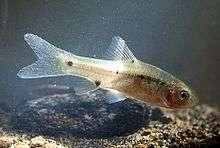Spotted barb
| Spotted barb | |
|---|---|
 | |
| Scientific classification | |
| Kingdom: | Animalia |
| Phylum: | Chordata |
| Class: | Actinopterygii |
| Order: | Cypriniformes |
| Family: | Cyprinidae |
| Genus: | Barbodes |
| Species: | B. binotatus |
| Binomial name | |
| Barbodes binotatus (Valenciennes, 1842) | |
| | |
| Nations where Puntius binotatus can be found | |
| Synonyms | |
| |
Barbodes binotatus,[2] commonly known as the spotted barb or common barb, is a tropical species of cyprinid fish native to Southeast Asia. It has also become established as an exotic species in Palau and Singapore.[3]
Description
Its color in life varies from a silvery gray to greenish gray, darker dorsally and paler or nearly white on its throat and belly. It has a bar behind the operculum on its shoulder. On large fish, body markings (spots or band) may be absent, except for the spot on the caudal base. It has a round, broad-tipped snout equal to or slightly larger than the eye. The fish will grow in length up to 7.75 inches (20.0 cm).
Distribution and habitat
Its native environment occurs from about sea level to above 2,000 m above sea level. It is commonly found below waterfalls in isolated mountain streams and on small islands inhabited by few other freshwater fish. It inhabits medium to large rivers, stagnant water bodies including sluggish-flowing canals and brooks of the middle Mekong. It is usually found in the middle to bottom depths of fairly shallow waters where it feeds on zooplankton, insect larvae and some vascular plants. They live in a tropical climate and prefer water with a 6.0 - 6.5 pH, a water hardness of 12.0 dGH, and a temperature range of 75 - 79 °F (24 - 26 °C).
Reproduction
An open water, substrate egg-scatter, the adult barbs will spawn around dawn.
Importance to humans
The spotted barb is of commercial importance in the aquarium trade and of minor importance in the fisheries industry.
See also
References
- ↑ Jenkins, A., Kullander, F.F. & Tan, H.H. 2009. Puntius binotatus. In: IUCN 2013. IUCN Red List of Threatened Species. Version 2013.2. <www.iucnredlist.org>. Downloaded on 26 November 2013.
- ↑ Kottelat, M. (2013): The Fishes of the Inland Waters of Southeast Asia: A Catalogue and Core Bibliography of the Fishes Known to Occur in Freshwaters, Mangroves and Estuaries. The Raffles Bulletin of Zoology, 2013, Supplement No. 27: 1–663.
- ↑ Froese, Rainer and Pauly, Daniel, eds. (2013). "Puntius binotatus" in FishBase. October 2013 version.
